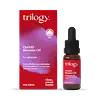What's inside
What's inside
 Key Ingredients
Key Ingredients

 Benefits
Benefits

 Concerns
Concerns

 Ingredients Side-by-side
Ingredients Side-by-side

Macadamia Integrifolia Seed Oil
Skin ConditioningSimmondsia Chinensis Seed Oil
EmollientHelianthus Annuus Seed Oil
EmollientSalvia Hispanica Seed Oil
MoisturisingNigella Sativa Seed Oil
EmollientCalophyllum Inophyllum Seed Oil
AntimicrobialUbiquinone
AntioxidantEuterpe Oleracea Fruit Oil
Skin ConditioningVaccinium Myrtillus Seed Oil
Skin ConditioningFragaria Ananassa Seed Oil
AntioxidantPunica Granatum Seed Oil
EmollientParfum
MaskingCitral
PerfumingCitronellol
PerfumingGeraniol
PerfumingLimonene
PerfumingLinalool
PerfumingMacadamia Integrifolia Seed Oil, Simmondsia Chinensis Seed Oil, Helianthus Annuus Seed Oil, Salvia Hispanica Seed Oil, Nigella Sativa Seed Oil, Calophyllum Inophyllum Seed Oil, Ubiquinone, Euterpe Oleracea Fruit Oil, Vaccinium Myrtillus Seed Oil, Fragaria Ananassa Seed Oil, Punica Granatum Seed Oil, Parfum, Citral, Citronellol, Geraniol, Limonene, Linalool
Water
Skin ConditioningSodium Ascorbyl Phosphate
AntioxidantAloe Barbadensis Leaf Juice
Skin ConditioningCamellia Oleifera Seed Oil
Skin ConditioningGlyceryl Stearate Citrate
EmollientPrunus Amygdalus Dulcis Oil
Skin ConditioningCetearyl Alcohol
EmollientGlycerin
HumectantSodium Hyaluronate
HumectantChenopodium Quinoa Seed Extract
Skin ConditioningPistacia Lentiscus Gum
MaskingAcacia Senegal Gum
MaskingSclerotium Gum
Emulsion StabilisingCaprylic/Capric Triglyceride
MaskingGlyceryl Caprylate
EmollientCitrus Glauca Fruit Extract
HumectantMicrocitrus Australasica Fruit Extract
Microcitrus Australis Fruit Extract
Skin ConditioningCeramide NP
Skin ConditioningXanthan Gum
EmulsifyingMica
Cosmetic ColorantPentylene Glycol
Skin ConditioningLecithin
EmollientSodium Benzoate
MaskingPotassium Sorbate
PreservativeGlyceryl Caprylate/Caprate
EmollientTin Oxide
AbrasiveCitric Acid
BufferingParfum
MaskingCaprylhydroxamic Acid
Benzyl Alcohol
PerfumingCI 77891
Cosmetic ColorantCI 77492
Cosmetic ColorantCitronellol
PerfumingCoumarin
PerfumingGeraniol
PerfumingHydroxycitronellal
PerfumingLimonene
PerfumingWater, Sodium Ascorbyl Phosphate, Aloe Barbadensis Leaf Juice, Camellia Oleifera Seed Oil, Glyceryl Stearate Citrate, Prunus Amygdalus Dulcis Oil, Cetearyl Alcohol, Glycerin, Sodium Hyaluronate, Chenopodium Quinoa Seed Extract, Pistacia Lentiscus Gum, Acacia Senegal Gum, Sclerotium Gum, Caprylic/Capric Triglyceride, Glyceryl Caprylate, Citrus Glauca Fruit Extract, Microcitrus Australasica Fruit Extract, Microcitrus Australis Fruit Extract, Ceramide NP, Xanthan Gum, Mica, Pentylene Glycol, Lecithin, Sodium Benzoate, Potassium Sorbate, Glyceryl Caprylate/Caprate, Tin Oxide, Citric Acid, Parfum, Caprylhydroxamic Acid, Benzyl Alcohol, CI 77891, CI 77492, Citronellol, Coumarin, Geraniol, Hydroxycitronellal, Limonene
Ingredients Explained
These ingredients are found in both products.
Ingredients higher up in an ingredient list are typically present in a larger amount.
Citronellol is used to add fragrance/parfum to a product. It is often derived from plants such as roses. In fact, it can be found in many essential oils including geranium, lavender, neroli, and more. The scent of Citronellol is often described as "fresh, grassy, and citrus-like".
Since the Citronellol molecule is already unstable, Citronellol becomes irritating on the skin when exposed to air.
Citronellol is a modified terpene. Terpenes are unsaturated hydrocarbons found in plants. They make up the primary part of essential oils.
Citronellol is not able to be absorbed into deeper layers of the skin. It has low permeability,
Citronellol is also a natural insect repellent.
Learn more about CitronellolGeraniol is used to add fragrance/parfum to a product. It is the main component of citronellol. It is a monoterpenoid and an alcohol.
Monoterpenes are naturally found in many parts of different plants.
Geraniol can be found in many essential oils including Rose Oil and Citronella Oil. The scent of Geraniol is often described as "rose-like". Many foods also contain Geraniol for fruit flavoring.
Geraniol can irritate the skin when exposed to air. However, irritation depends on the ability of geraniol to penetrate into the skin. In general, geraniol is not able to penetrate skin easily.
Geraniol is colorless and has low water-solubility. However, it is soluble in common organic solvents.
Like citronellol, it is a natural insect repellent.
2,6-Octadien-1-ol, 3,7-dimethyl-, (2E)-
Learn more about GeraniolLimonene is a fragrance that adds scent and taste to a formulation.
It's found in the peel oil of citrus fruits and other plants such as lavender and eucalyptus. The scent of limonene is generally described as "sweet citrus".
Limonene acts as an antioxidant, meaning it helps neutralize free radicals.
When exposed to air, oxidized limonene may sensitize the skin. Because of this, limonene is often avoided by people with sensitive skin.
The term 'fragrance' is not regulated in many countries. In many cases, it is up to the brand to define this term. For instance, many brands choose to label themselves as "fragrance-free" because they are not using synthetic fragrances. However, their products may still contain ingredients such as essential oils that are considered a fragrance.
Learn more about LimoneneParfum is a catch-all term for an ingredient or more that is used to give a scent to products.
Also called "fragrance", this ingredient can be a blend of hundreds of chemicals or plant oils. This means every product with "fragrance" or "parfum" in the ingredients list is a different mixture.
For instance, Habanolide is a proprietary trade name for a specific aroma chemical. When used as a fragrance ingredient in cosmetics, most aroma chemicals fall under the broad labeling category of “FRAGRANCE” or “PARFUM” according to EU and US regulations.
The term 'parfum' or 'fragrance' is not regulated in many countries. In many cases, it is up to the brand to define this term.
For instance, many brands choose to label themselves as "fragrance-free" because they are not using synthetic fragrances. However, their products may still contain ingredients such as essential oils that are considered a fragrance by INCI standards.
One example is Calendula flower extract. Calendula is an essential oil that still imparts a scent or 'fragrance'.
Depending on the blend, the ingredients in the mixture can cause allergies and sensitivities on the skin. Some ingredients that are known EU allergens include linalool and citronellol.
Parfum can also be used to mask or cover an unpleasant scent.
The bottom line is: not all fragrances/parfum/ingredients are created equally. If you are worried about fragrances, we recommend taking a closer look at an ingredient. And of course, we always recommend speaking with a professional.
Learn more about Parfum